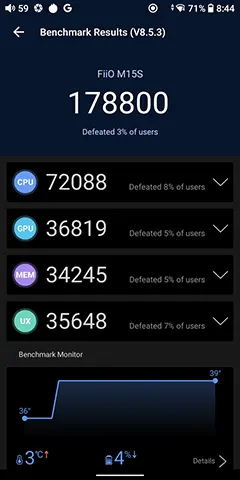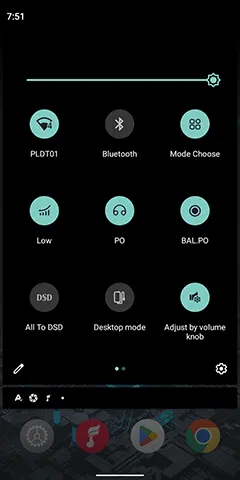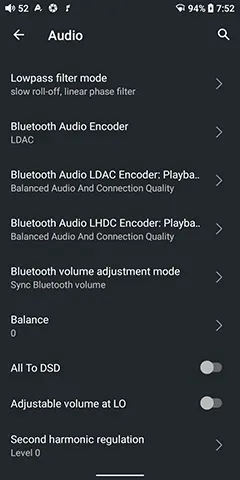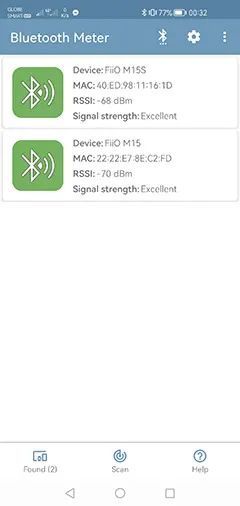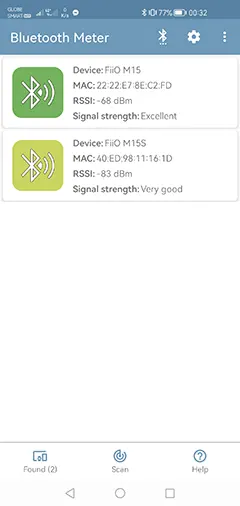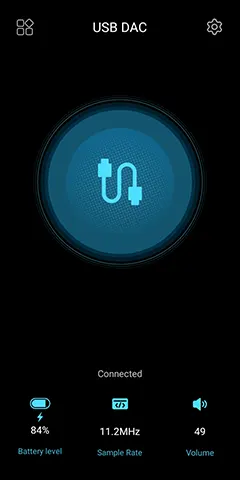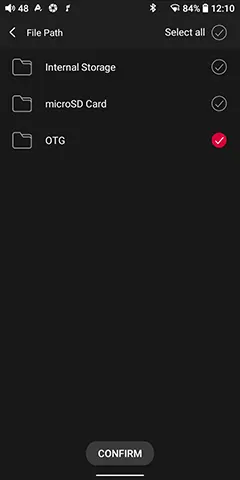Software Impressions
The FiiO M15s uses an Android 10 software platform powered by a Snapdragon 660 SoC and 4GB of RAM. That brings it up to speed with most of their recent releases including the flagship M17 which uses a similar platform.
Sadly, it’s not the most modern platform with the likes of HiBy now using Android 12 on the RS8 and their new R6 Pro II as well as the recent upgrade to Android all on the DX240. However, it is a huge upgrade on the older M15‘s Android 7 powered by the Samsung Exynos 7872 CPU with 3GB of RAM which is now well out of date.
Switching to a more modern Android version is aesthetically more pleasing but it also unlocks BT5.0 capability. This is something that was not possible on Android 7 and you can see FiiO make a big play of the M15S BT5.0 chipset and its capabilities in the M15S marketing.
Out of the box, the M15S Android 10 OS is relatively bloat-free and Google Play compatible with the Google Play store and services preinstalled and working perfectly fine.
You still get a few FiiO-focused apps but I find them generally helpful or essential such as their technical app which acts as a one-stop-shop for OTA services, manuals, and general support services.
You also get FiiO’s own Music app and as with most recent DAP launches since the end of December 2022, the M15S is Roon Ready with its own lightweight FiiO Roon app that will work as an endpoint with your chosen core.
Performance Benchmarking
This is where the switch to the Snapdragon 660 SoC over the older Samsung Exynos 7872 CPU plus the additional 1GB of RAM is going to be felt. The performance of the M15S is much faster with higher scores across all the key indicators in AnTuTu with a headline score that’s over 50% higher.
That should mean better multitasking from the M15S in Android mode as well as improved buffering with the additional RAM capacity for the likes of hi-res streaming. A little dig in behind also shows a slightly better CPU clock rate on the M15S at 633.6-2208.0 MHz compared to the M15’s 449.0-1976.0 MHz setting.
Now, in context to the current competition, the M15S is more or less on par with the likes of the older HiBy R8 and the R6 2020. It is actually not that far behind the Cayin N7 either which also uses 4GB of RAM but with Android 13 and the newer Snapdragon 665 SoC.
However, it is a little bit behind the HiBy R6 III going by James’s AnTuTu scores. I would rate the M15S speed as joining the pack of contenders but not yet a class leader.
UI Flow
FiiO always does a pretty decent job with its UI though it differs from the likes of Cayin and HiBy with more of an iOS-type lateral screen flow than a specific apps tray.
That means new apps will be added to the lateral screen cards rather than into a specific Android apps tray. You can opt for gesture or icon-based control points at the base of the screen through the settings menu.
With Android 10 you can also long-press the apps to give you some additional fast access actions which were not possible on Android 7.
For example, long pressing on the FiiO Music app will give you a pop-up message screen just above the app inviting you to quickly the media server, local music, playlists, or resume playback options without having to first open the app.
Dropdown Menu
The drop-down menu is still closer to the Android 7 layout compared to what you see on the Cayin and HiBy Android 13 layouts though stylistically it looks a lot nicer than the older M15 version with the ability to use a dark theme.
That dark theme also tidies up the main Android settings menu nicely and gives a cleaner more focused look compared to the equivalent thin font layout of the M15’s Android 7 equivalent.
The drop-down menu is stuffed full of pretty much all of the instant access options you will need to operate the M15S. That includes the 5-stage gain system though the 5th gain, Ultra High, will only become active once you are plugged into a fast charging complaint system.
Other options include the quick access mode choice menu, an ability to switch from PO to LO on both balanced and single-ended outputs, as well as the option to upsample to DSD, (all-to-DSD) and your normal wireless connection modalities.
Features
We have gone through the core feature sets of most FiiO DAPs extensively down through the years so I wanted to do is just draw your attention to some of the specific areas that stand out as being either new or beneficial to the listening experience.
Roon Ready
This is one of the big adds to FiiO’s DAP lineup since a firmware update in late Dec 2022. Not just the M15S but also the M17 and a few of their midrange DAPs have access to this also.
I do not believe the older M15 is Roon Ready though as it has not had an update in a few years now but you can still load the Roon Endpoint app, (as also the M15S), and use it in the traditional manner.
The M15S will show up as Roon Ready in your Roon core so you simply enable it and you should be good to go. How does it transfer to the M15S? Well, FiiO has included a very simple and easy-to-use app called FiiO Roon which is more like a window for the Roon Core to show you what it is transmitting to playback on the M15S.
You have a small measure of playback control as well as the ability to see what is being played and the sample rate of the source file including all relevant meta tags and artwork. From my experience of using it, the app is flawless so long as your core/endpoint connection is stable.
All To DSD
This is a feature I have overlooked in the past but I would encourage you to try it during playback. You can find it in the drop-down navigation menu as an icon somewhere at the base of the curtain.
Basically, it converts PCM to DSD in an attempt to improve the general sound quality of the audio track being placed, (if PCM). The process of conversion is a method of upsampling via algorithm before it hits the DAC for conversion to analog with some additional noise shaping.
Now, it will drain your battery and up the general temperature of the M15S so I do not suggest keeping this on always if those conditions might bother you.
You will know that it is turned on as the sample rate indicator in the notifications bar has a constant reading of 2.8M which is equivalent to DSD64 playback even if your file is MP3 or FLAC 16BIT/44.1k.
In a snapshot, All To DSD brings in a very subtle refinement to leading edges with a general perception of enhanced detail of instrumental and vocal notes out of my own personal experience using it. Not always but if you do spot it’s likely to be more on stringed instruments such as guitar plucks that are more prominent.
Mode Choices
Since the M15 review, the M15S mode choices have also expanded. Even now with the latest firmware version on the original M15, we are still on 4 choices as opposed to 5 with the additional choice on the M15S being an AirPlay mode which works quite smoothly on testing with an iPhone Mini 13.
Basically, mode choices give you a central single screen through which you can branch off into any aspect of the M15S playback capability. That includes stock local Android and Pure mode playback, the USB-DAC and BT receiving modes as well as the aforementioned AirPlay mode for Apple gear users on WiFi.
It’s pretty easy to access also being a single action icon in the dropdown menu saving you a lot of time hunting around in the audio menu settings or just wondering where to access these features might be.
Second Harmonic Regulation
If you go through the main Android settings menu and enter the audio settings, just scroll down to the very bottom and you will see a single-line entry called “Second Harmonic Regulation”.
Basically, what this does is inject a very subtle level of second-order distortion into the playback, similar to what a tube amp performance might offer, or at least that is the comparison and aim FiiO is going for.
It comes with 3 levels denoted as Level 0, 1, and 2 with level 0 being the default level and offering the least amount of second-order presence and 2 being the highest.
There is a caveat to this and that is FiiO’s comment that the second harmonic regulation feature is only really noticeable in high volume or high gain modes so effectively it is a feature worth considering in desktop mode or super high gain mode with headphones rather than low gain IEMs.
I put this to the test with a vocal mix I know is extremely unforgiving with sharp sibilance, Ariana Grande’s “34+35” from bright or neutral-sounding headphones and sources. Paired with a HIFIMAN Arya Stealth Magenet Edition in ultra-high gain with Level 0 the sharpness in the vocal leading edges was immediately clear in the first 10 seconds.
Switching to Level 2 softened the sibilance noticeably without upsetting the general tonal quality of both source and headphones and made it a more pleasing listening experience.
Level 1 was more marginal so if you are looking to soften the sound of a bright mix or headphones I would go all out on Level 2 to get a noticeable result.
Wireless Performance
WiFi Signal Strength
To test the WiFi signal strength, we decided to assess how the M15S performed or competed against the older M15 since both have dual 2.4/5GHz IEEE 802.11 antennae. We tested with a WiFi modem signal from about 7m away which is kind of normal for our modem’s performance in these tests.
We ran the test for 5 minutes in a similar fixed location with screenshots every 30 seconds or so and calculated the mean of all results combined.
The above screenshots are the highest peaks during the test and you can see clearly that the antennae inside both DAPs are performing equally as well showing no significant difference. Note, however, both DAPs latched onto our modem’s 2.4G signal and not the 5G signal and here the M15S seems to cope better with a faster Mbps speed.
Bluetooth Signal Strength
This was a surprising test for me, both qualitatively and subjectively. In both instances of our BT test, the M15 showed a stronger signal the further away we went.
Testing was done from 2 different distances, 1m and 3m away, to reflect a wide variety of usage conditions such as a TWS in your ear and DAP in your pocket or a fixed transmission point for the M15S. Our test smartphone was a Huawei Mate Xs2 and a Samsung Flip 3.
This test was done over 5 minutes with regular screenshots taken over that period. The above pictures demonstrate the highest performance from 1m and 3m away which clearly showed that neither DAP showed any significant signal strength advantages over the other from 1m away but the M15 had a better dBm reading from 3m away.
This was backed up by my subjective testing using the Noble Audio Mystique TWS in aptX mode and simply walking to a further point in the apartment and seeing when the signal would start to stutter and break up. In this instance, the M15S signal became intermittent about 1-2 meters before the M15 signal.
I can only conclude that the different internal designs including isolation techniques from EMI combined with the chassis materials and the amount of power the Qualcomm chipset is receiving might be factors in the M15S’s slightly reduced long-range BT performance compared to the original M15.
Streaming
The M15S has no issues with 3rd party streaming compatibility and network-based alternatives such as DLNA and AirPlay. Even FiiO’s own Music app has a simple Media Server option on the home screen to allow you to directly access any existing streaming services you have set on a NAS or anything with a fixed IP for audio playback.
You can install TIDAL, Spotify, or Qobuz easily enough or work from Roon via the FiiO Roon app or using the Roon Endpoint app. Roon Arc should be compatible also and I had no issues finding the core and my username but I had some challenges setting it up beyond that due to our modem’s configuration for IPV4 connectivity.
One thing I noticed with MQA via TIDAL is that the M15S indicated the true sample rate as set by TIDAL, for example, 96k, unlike HiBy or Cayin DAPs that show unfolded rates of up to 705k or 768k.
A bit of digging into why this is the case reveals that it was MQA themselves who requested FiiO to display the original sample rate in the status bar rather than the unfolded sample rate which is a bit of a bummer.
Wired Performance
USB-DAC
I would encourage you to download and install the FiiO ASIO driver and accompanying software for managing it within Windows to get the M15S optimal for playback. It is universal plug-and-play compatible but where possible I always prefer to use ASIO drivers. For MAC owners the M15S is plug-and-play for USB-DAC as you might expect.
Once installed and the M15S is connected simply dive into your mode choices and select USB-DAC which should bring you to a single blue screen that will show you the sample rate, volume, and battery life during playback.
Unlike HiBy’s adaptation, there is no USB-DAC to BT transmitting mode accessible from the USB-DAC screen. You also cannot go into the M15S desktop mode during USB-DAC playback since the single USB socket is already used for data transfer, unlike the M17.
There are no issues with bus power with the USB connection so you can connect the M15S to a USB-A or C port with 0.5mAh of output power and it will work just fine.
USB-OTG
The M15S is compatible with both OTG flash expansion and OTG digital audio for output to something like a dongle or a more powerful device such as a Chord Electronics Mojo 2.
However, Much like how the Cayin N7 operates, if you allow exclusive use of the USB output from the FiiO Music app then dongles such as the Questyle M15 will output at full volume with no USB driver volume control capability from the M15S.
Something new for OTG capability that was not part of the original M15 review and that is the ability for OTG flash expansion cards to have their media tracks recognized and integrated into the main media management database of the FiiO Music app in Android.
Now this is an app-specific update so do not panic original M15 owners, you also have the same FiiO Music media library integration capability since the latest version is also compatible with the older DAP.


